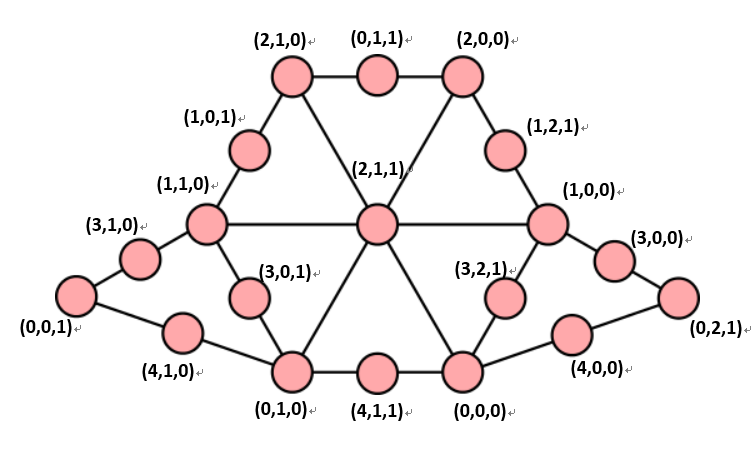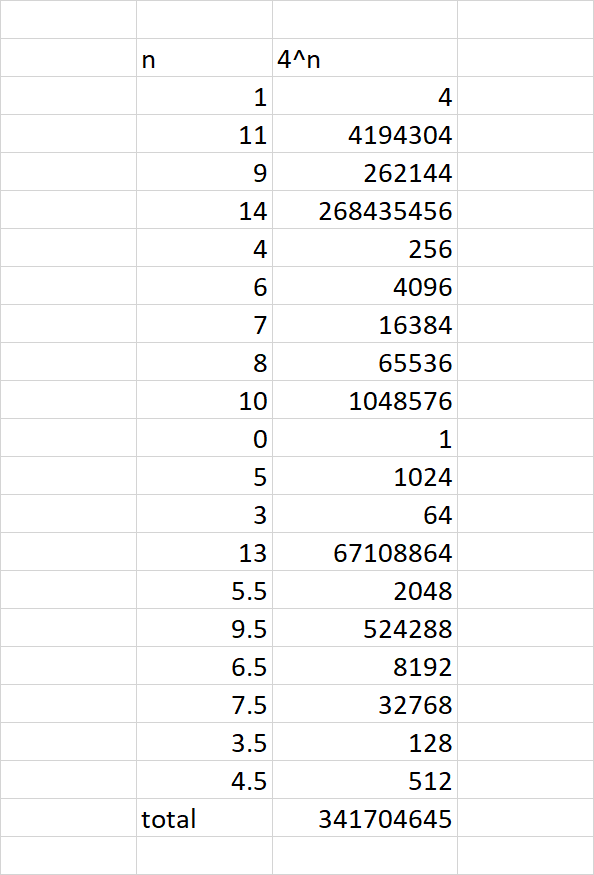Place 19 different positive integers on the vertices of this graph so that the 13 products of three numbers in a straight line are all equal. Do so in such a way that the product is as small as possible.
-
$\begingroup$ There are several '3-in-a-row' in your diagram, e.g. top-middle, middle, bottom-middle. Do these count, or must they be on an actual line? $\endgroup$– JMPCommented Aug 26, 2019 at 4:14
-
$\begingroup$ @JonMarkPerry The 13 products on actual lines. $\endgroup$– Bernardo Recamán SantosCommented Aug 26, 2019 at 12:03
-
$\begingroup$ Well, you could add a few then. OK's answer gives (4,7,10), (11, 7,3) and (14,7,0) as at least three more answers! (I suppose this messes with minimality though). $\endgroup$– JMPCommented Aug 26, 2019 at 12:05
-
$\begingroup$ @JonMarkPerry Yes, it would mess the minimum by a lot! $\endgroup$– Bernardo Recamán SantosCommented Aug 26, 2019 at 13:46
2 Answers
Final Short Answer:
Derivation Process:
By observation, this graph is composed with many triangles, so that maybe "3" is the key to identify the "dimension" or "vector" concept.
By unique factorization theorem, every positive integer can be represented as the product of prime numbers and this representation is unique.
Based on above 2 reasons, I tried to solve this question with the form $a^x b^y c^z$. And by the theorem, every unique tuple $(x,y,z)$ ensures that $a^x b^y c^z$ is also unique.
Thus for base $a,b,c$, I picked the smallest primes $2,3,5$. Then we need at least 19 different integers to fill in the vertex, so I began to try $x=y=z=2$ due to there are 27 unique integer candidates vary from $2^03^05^0$ to $2^23^25^2$, but not working.
Then I tried with $x=y=z=3$, and it works :P
$(x,y,z)$ denotes the integer $2^x3^y5^z$, ex: $(1,1,2) \to 2^13^15^2 = 150$
The tuple/vector summation for all lines are $(3,3,3)$, hence the product is $2^33^35^3 = 27,000$
Improved:
Well, thanks the hint from question owner, I now tried out with the form $2^x3^y$:
Since the graph is line-symmetry, so that vertex which are on the center line should have $x=y$ property, and the rest should be symmetric, forming the property $(x,y) \to (y,x)$, from left to right.
Thus now the minimum product is reduced to $2^53^5 = 7,776$
Improved again:
This time I abandoned the symmetry approach due to some lower vector $(0,0)$ and $(1,1)$ are not used, $(x,y)$ need to be more "compact" when fill in the vertex.
Thus I attempted to put some lowers like $(0,1)$ or $(1,0)$ in joint vertex and put some highers like $(4,3)$ or $(3,4)$ in side vertex, and worked out:
Now the minimum is reduced again to $2^43^4 = 1,296$
I hope it is the final optimal answer and worth at least 30 upvotes :P
Improved again & again:
Need to reduce once more. Based on the upper limit $2^43^4 = 1,296$, I've listed all possibilities for the minimum which product is lower than $1,296$ and integer candidates are at least 20(due to we need 19 different integers to fill in):
- $2^23^25^17^1 = 1,260 (36)$
- $2^73^2 = 1,152 (24)$
- $2^33^35^1 = 1,080 (32)$
- $2^23^25^2 = 900 (27)$
- $2^53^3 = 864 (24)$
- $2^43^25^1 = 720 (30)$
- $2^63^2 = 576 (21)$
- $2^43^3 = 432 (20)$
- $2^23^15^17^1 = 420 (24)$
- $2^33^25^1 = 360 (24)$
And begin try and error process, finally worked out one:
Now the minimum is reduced again & again to $2^43^25^1 = 720$
I hope it's the optimal minimum :(
-
$\begingroup$ Nice, but not the minimum known to me. $\endgroup$ Commented Aug 26, 2019 at 15:04
-
1$\begingroup$ Not far, and uses precisely the ideas you are trying. $\endgroup$ Commented Aug 26, 2019 at 15:17
-
1$\begingroup$ @Conifers Nearly there! $\endgroup$ Commented Aug 26, 2019 at 16:54
-
1$\begingroup$ @BernardoRecamánSantos I got some idea, wait me for a while :P $\endgroup$– ConifersCommented Aug 27, 2019 at 8:20
-
1$\begingroup$ @Conifers No, I don´t know of any straightforward way of finding the minimum. In fact, I was surprised (and shocked!) to see you had lowered the minimum I had in mind (1080). I start from abundant numbers and construct plausible magic graphs using their many divisors. I don´t really know how to go backwards efficiently other then by pondered trial and error. $\endgroup$ Commented Aug 30, 2019 at 2:16
Inspired by another answer in another similar genre of question (forgot which one but I think the answer is by @Deusovi), this problem can be simplified to addition and then changing each number n in the circle to $4^n$ to achieve the task. Apparently this isn’t the optimal one, because the total product of all the numbers is
341704645
While the total product of each line is
$4^{13}$
The diagram of n’s [The lines are somehow missing :(]:
The Excel of conversion:
-
$\begingroup$ Can I see 8, 7.5, 4.5 (=20)? (right side) $\endgroup$– JMPCommented Aug 26, 2019 at 7:53
-
$\begingroup$ @Jon should be 8.5 instead of 7.5, will update later, thanks! $\endgroup$ Commented Aug 26, 2019 at 7:56








